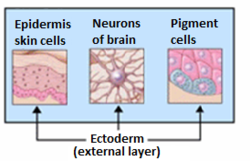Ectoderm
| Ectoderm | |
|---|---|

Organs derived from ectoderm.
|
|

Section through embryonic disk of Vespertilio murinus.
|
|
| Details | |
| Days | 16 |
| Identifiers | |
| MeSH | A16.254.425.273 |
| FMA | 69070 |
|
Anatomical terminology
[]
|
|
Ectoderm is one of the three primary germ layers in the very early embryo. The other two layers are the mesoderm (middle layer) and endoderm (most proximal layer), with the ectoderm as the most exterior (or distal) layer. It emerges and originates from the outer layer of germ cells. The word ectoderm comes from the Greek ektos meaning "outside", and derma, meaning "skin."
Generally speaking, the ectoderm differentiates to form the nervous system (spine, peripheral nerves and brain), tooth enamel and the epidermis (the outer part of integument). It also forms the lining of mouth, anus, nostrils, sweat glands, hair and nails.
In vertebrates, the ectoderm has three parts: external ectoderm (also known as surface ectoderm), the neural crest, and neural tube. The latter two are known as neuroectoderm.
Heinz Christian Pander, a Baltic German–Russian biologist, has been credited for the discovery of the three germ layers that form during embryogenesis. Pander received his doctorate in zoology from the University of Wurzburg in 1817. He began his studies in embryology using chicken eggs, which allowed for his discovery of the ectoderm, mesoderm and endoderm. Due to his findings, Pander is sometimes referred to as the "founder of embryology".
...
Wikipedia
